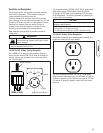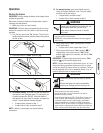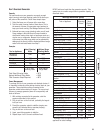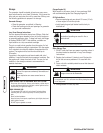
Connecting Electrical Loads
1. Let engine stabilize and warm up for a few minutes
after starting.
2. Plug in and turn on the desired 120 and/or 240 Volt AC,
single phase, 60 Hz electrical loads.
NOTE:
• DO NOT connect 240 Volt loads to the 120 Volt duplex
receptacles.
• DO NOT connect 3-phase loads to the generator.
• DO NOT connect 50 Hz loads to the generator.
• DO NOT OVERLOAD THE GENERATOR. See Don’t
Overload Generator.
Stopping the Engine
1. Turn OFF and unplug all electrical loads from generator
panel receptacles. NEVER start or stop engine with
electrical devices plugged in and turned ON.
2. Let engine run at no-load for several minutes to
stabilize internal temperatures of engine and generator.
3. Push engine rocker switch to “Off” position.
4. Move fuel valve to “Off” position.
Warm Weather Operation
This generator engine is equipped with WeatherGuard, an
innovative feature to prevent carburetor icing in cold weather
conditions. WeatherGuard has been engineered to operate in
all weather conditions. However, product performance can
be increased when operating the generator solely in warm
weather by removing the WeatherGuard shield (A).
Remove the two nuts (B) and loosen the fastener (C) as
shown. Store shield and fasteners for future cold weather
operation.
14 BRIGGSandSTRATTON.COM
WARNING
Backfire, fire or engine damage could occur.
• DO NOT stop engine by moving choke control to “Choke”
position
().
NOTICE
Exceeding generators wattage/amperage capacity can
damage generator and/or electrical devices connected to it.
• DO NOT exceed the generator’s wattage/amperage capacity. See
Don’t Overload Generator in the Operation section.
• Start generator and let engine stabilize before connecting
electrical loads.
• Connect electrical loads in OFF position, then turn ON for
operation.
• Turn electrical loads OFF and disconnect from generator before
stopping generator.
B
C
A


















